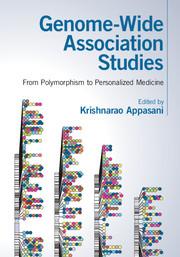Book contents
- Frontmatter
- Dedication
- Contents
- List of contributors
- Forewords
- Preface
- List of abbreviations
- Part I Genome-wide association studies
- Part II Genome-wide studies in disease biology
- Part III Single nucleotide polymorphisms, copy number variants, haplotypes and eQTLs
- 10 Finding SNPs that affect microRNA regulation in disease-associated genomic regions
- 11 From linkage to complex associations: the role of GABRA2 as a risk factor for alcohol use
- 12 Copy number variation in monozygous twins
- 13 Haplotypes of CpG-related SNPs and associations with DNA methylation patterns
- 14 eQTL mapping
- Part IV Next-generation sequencing technology and pharmaco-genomics
- Part V Population genetics and personalized medicine
- Index
- Plate section
- References
10 - Finding SNPs that affect microRNA regulation in disease-associated genomic regions
from Part III - Single nucleotide polymorphisms, copy number variants, haplotypes and eQTLs
Published online by Cambridge University Press: 18 December 2015
- Frontmatter
- Dedication
- Contents
- List of contributors
- Forewords
- Preface
- List of abbreviations
- Part I Genome-wide association studies
- Part II Genome-wide studies in disease biology
- Part III Single nucleotide polymorphisms, copy number variants, haplotypes and eQTLs
- 10 Finding SNPs that affect microRNA regulation in disease-associated genomic regions
- 11 From linkage to complex associations: the role of GABRA2 as a risk factor for alcohol use
- 12 Copy number variation in monozygous twins
- 13 Haplotypes of CpG-related SNPs and associations with DNA methylation patterns
- 14 eQTL mapping
- Part IV Next-generation sequencing technology and pharmaco-genomics
- Part V Population genetics and personalized medicine
- Index
- Plate section
- References
Summary
Introduction
MicroRNAs (miRNAs) are small, single-stranded RNAs of about 22 nucleotides involved in gene regulation by binding to 3′ untranslated regions (UTRs) of messenger RNAs (mRNAs) (Bartel, 2004). By bringing the RNA-induced silencing complex (RISC) to the mRNAs, they enable gene expression inhibition (gene silencing), either by affecting protein translation or by destabilizing mRNAs through deadenylation or decapping (Fabian et al., 2010). Target mRNAs are recognized by miRNAs through Watson–Crick matching between the nucleotides two to seven of the 5′ end of miRNAs (seed sequences), and complementary sequences called seed sites in the 3′ UTR of mRNAs (Bartel, 2009). Gene silencing by miRNAs is an important mechanism in physiological processes, and its deregulation can lead to complex diseases such as cancer (Garzon et al., 2006).
Complex diseases that are heritable are commonly analysed by studying genomic DNA variants, such as single nucleotide polymorphisms (SNPs), which are a change of one nucleotide that occurs in more than 1% in a population (Frazer et al., 2009). A SNP can take several forms called alleles. Because recombination events between closely located SNPs are less likely than recombination between SNPs that are located far apart on a chromosome, alleles at close SNPs often co-occur, or correlate, in which case the SNPs are said to be in linkage disequilibrium (LD; Reich et al., 2001; Clague et al., 2010).
SNPs in the coding sequence of mRNAs have been well studied for their role in changing the amino-acid chain, as it may result in protein isoforms with affected function, leading to phenotypic differences and also disease. Nevertheless, SNPs can also occur in non-coding regions of the genome such as the 3′ UTR of mRNAs, which harbors many functional sequence elements involved in gene regulation. One type of functional element that can be disrupted by SNPs is the miRNA target site. SNPs in miRNA target sites (miRSNPs) can change the affinity between the miRNA seed sequence and its target mRNA, resulting in deregulation of gene expression (Figure 10.1), and possibly in phenotype differences and diseases (Sethupathy and Collins, 2008).
One classic example that a miRSNP determines phenotype is the single nucleotide change in the myostatin gene (GDF8) of Texel sheep (Clop et al., 2006).
- Type
- Chapter
- Information
- Genome-Wide Association StudiesFrom Polymorphism to Personalized Medicine, pp. 139 - 150Publisher: Cambridge University PressPrint publication year: 2016

